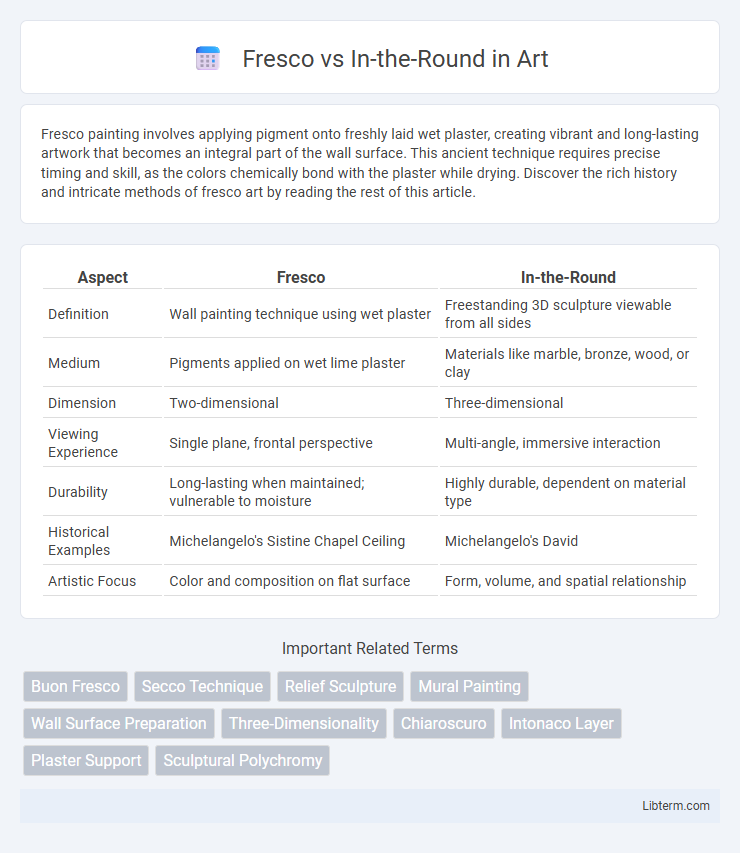Fresco painting involves applying pigment onto freshly laid wet plaster, creating vibrant and long-lasting artwork that becomes an integral part of the wall surface. This ancient technique requires precise timing and skill, as the colors chemically bond with the plaster while drying. Discover the rich history and intricate methods of fresco art by reading the rest of this article.
Table of Comparison
| Aspect | Fresco | In-the-Round |
|---|---|---|
| Definition | Wall painting technique using wet plaster | Freestanding 3D sculpture viewable from all sides |
| Medium | Pigments applied on wet lime plaster | Materials like marble, bronze, wood, or clay |
| Dimension | Two-dimensional | Three-dimensional |
| Viewing Experience | Single plane, frontal perspective | Multi-angle, immersive interaction |
| Durability | Long-lasting when maintained; vulnerable to moisture | Highly durable, dependent on material type |
| Historical Examples | Michelangelo's Sistine Chapel Ceiling | Michelangelo's David |
| Artistic Focus | Color and composition on flat surface | Form, volume, and spatial relationship |
Introduction to Fresco and In-the-Round
Fresco is a mural painting technique where pigments are applied onto freshly laid wet plaster, allowing colors to become an integral part of the wall surface, often seen in historical and architectural settings. In-the-round refers to sculptural works designed to be viewed from all sides, emphasizing three-dimensional form and spatial interaction. Both techniques highlight distinct artistic approaches: fresco integrates art with architectural surfaces, while in-the-round sculptures emphasize volumetric presence in space.
Historical Origins of Fresco Art
Fresco art originated in ancient civilizations such as the Minoans and Egyptians, with mastery peaking during the Italian Renaissance, notably in works by Michelangelo and Raphael. This technique involves applying pigment onto freshly laid lime plaster, allowing for long-lasting, vibrant murals integral to architectural surfaces. In contrast, in-the-round sculptures, emerging prominently in classical antiquity, are fully three-dimensional works designed to be viewed from all sides, emphasizing form over the painted narrative of frescoes.
Evolution of In-the-Round Sculpture
In-the-round sculpture evolved significantly from its early origins, transitioning from simplistic, frontal representations to fully three-dimensional, dynamic forms intended for viewing from all angles. This evolution highlights a move towards greater realism and spatial interaction, unlike fresco murals, which are inherently two-dimensional and fixed on surfaces. Advances in materials and techniques enabled sculptors to explore complex compositions and lifelike textures, distinguishing in-the-round sculpture as an expressive and immersive art form.
Key Techniques in Fresco Painting
Fresco painting involves applying pigment onto freshly laid wet lime plaster, allowing the colors to chemically bond with the surface for durability and vibrancy. Key techniques include the use of intonaco, the fine layer of plaster applied in sections called "giornate," which ensures precise timing for pigment application. Unlike in-the-round sculpture that emphasizes three-dimensional form, frescoes focus on creating durable, vibrant images through meticulous layering and pigment absorption in the plaster.
Crafting In-the-Round Sculptures: Methods and Materials
Crafting in-the-round sculptures involves shaping three-dimensional artworks fully viewable from all sides, typically using materials like clay, stone, bronze, or wood that allow detailed textural work and structural integrity. Techniques include additive methods such as clay modeling and wax building for bronze casting, as well as subtractive methods like carving marble or wood, each demanding precision and an understanding of material properties to achieve balance and durability. Unlike fresco painting, which applies pigment to wet plaster on walls, in-the-round sculpture focuses on physical form and volume, requiring robust frameworks or armatures to support complex compositions through various sculpting tools and casting processes.
Fresco vs. In-the-Round: Artistic Intent and Expression
Fresco technique involves painting directly onto wet plaster, creating a permanent bond between pigment and wall that emphasizes narrative continuity and large-scale visual storytelling. In-the-round sculpture presents three-dimensional forms meant to be viewed from multiple angles, offering dynamic interaction and spatial exploration in artistic expression. The fresco's flat, expansive surfaces contrast with the in-the-round's tangible volume, reflecting distinct artistic intents focused respectively on immersive storytelling versus physical presence and viewer engagement.
Famous Frescoes in Art History
Famous frescoes such as Michelangelo's Sistine Chapel ceiling and Giotto's Scrovegni Chapel paintings exemplify the immersive, wall-bound nature of the fresco technique, which involves applying pigment to wet plaster for durable, vibrant murals. In contrast, in-the-round sculpture, epitomized by works like Michelangelo's David and Rodin's The Thinker, offers a fully three-dimensional form viewed from all angles, emphasizing volume and spatial presence. Frescoes capture narrative scenes on architectural surfaces, embedding art into the structure, while in-the-round sculptures engage viewers through their physicality and free-standing design.
Notable In-the-Round Sculptures Worldwide
Notable in-the-round sculptures worldwide include Michelangelo's David in Florence, showcasing intricate details viewable from all angles, and Auguste Rodin's The Thinker in Paris, a masterpiece emphasizing human introspection through full 360-degree visibility. Unlike frescoes, which are two-dimensional murals painted on walls, in-the-round sculptures occupy three-dimensional space, allowing viewers to experience their forms from multiple perspectives. These sculptures are celebrated globally for their artistic depth and interactive spatial presence, contrasting the static, surface-bound nature of fresco art.
Preservation and Restoration Challenges
Fresco murals, painted on wet plaster, face challenges like moisture infiltration and plaster deterioration, requiring careful environmental control and expert consolidation techniques for preservation. In-the-round sculptures, exposed on all sides, are vulnerable to physical damage and surface erosion, demanding regular cleaning, protective coatings, and structural stabilization during restoration. Both art forms necessitate specialized approaches tailored to their material composition and environmental exposure to ensure long-term conservation.
Choosing Between Fresco and In-the-Round for Modern Artists
Choosing between fresco and in-the-round techniques involves considering factors like surface permanence and dimensionality. Fresco offers a durable, wall-bound method with vivid pigment integration, ideal for large-scale murals requiring longevity and historical resonance. In-the-round sculptures provide dynamic, fully three-dimensional forms allowing modern artists to explore spatial interaction and viewer engagement from multiple angles.
Fresco Infographic

 libterm.com
libterm.com